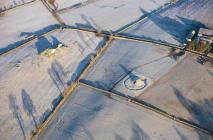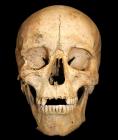Neolithic Burial Chambers
Items in this story:
The first sense of place
The Neolithic revolution of the third and fourth millennia BC enabled communities to change their environment in profound ways. The clearance of the forests, regular planting of crops, animal husbandry and the founding of small semi permanent settlements meant that for the first time individuals experienced a connection with their land – a sense of place. Unsurprisingly they created the first major monuments in the Welsh landscape, the best known and most durable of which are their chambered tombs. Communal burial sites, they were created to celebrate the ancestors and underline the community’s ownership and spiritual connection with the land.
Pentre Ifan
The most famous and perhaps the finest surviving is Pentre Ifan, near Nevern in northern Pembrokeshire. Its chamber is formed by a capstone of around 16 tonnes upheld on three uprights about 2.5m high at one end of a cairn some 30 m long. The tomb was excavated by W F Grimes in 1936-7, who thought that it was heavily influenced by prehistoric contacts with Ireland. More recent research suggests the tomb was an indigenous creation by the local communities but may have been nonetheless influenced by Irish culture and contact during a later stage of its use, when the long mound, long since eroded away, was extended. Its present appearance, as a gaunt freestanding structure supporting a delicately balanced capstone, may never have been witnessed by the communities who later used it. Instead, it is thought that the whole structure was covered in a massive mound or cairn of stones with access to the chamber permitted only through the door or ‘portal’ at the south end.
Pen-y-wrlod
Breconshire's hills and deep wooded valleys have probably not yet yielded all their Neolithic tombs. One sizeable example went unnoticed at Pen-y-wrlod near Talgarth until 1972 when it was discovered during quarrying. Subsequent excavation yielded some of the best-preserved skeletal remains known from any Neolithic tomb in Wales, enabling the facial reconstruction of one of the 5,500-year-old skulls.
'they sayd they sawe strange apparitions'
Tŷ Illtud, near Llanfrynach in southern Powys, is one of the most rewarding of the tombs to visit. A history of digging and quarrying has left the chamber exposed in a slight hollow. Some unusual incised graffiti can be seen on the inner face of the chamber. These are accessed by crawling inside, where the visitor is confronted by a wall of crosses and chevrons, and even a carving of a five-stringed lyre. Although similar to some Neolithic tomb art from Wales and Ireland, they are probably the marks of medieval masons who quarried from the nearby flagstone outcrop. John Aubrey, the seventeenth century antiquarian, was probably describing Tŷ Illtud when he wrote, ‘…under this Carn is hid great treasure. The Doctor caused it to be digged; and there rose such a horrid tempest of thunder and lightening, that the workmen would work no longer; and they sayd they sawe strange apparitions.’
Story contributed by: RCAHMW



